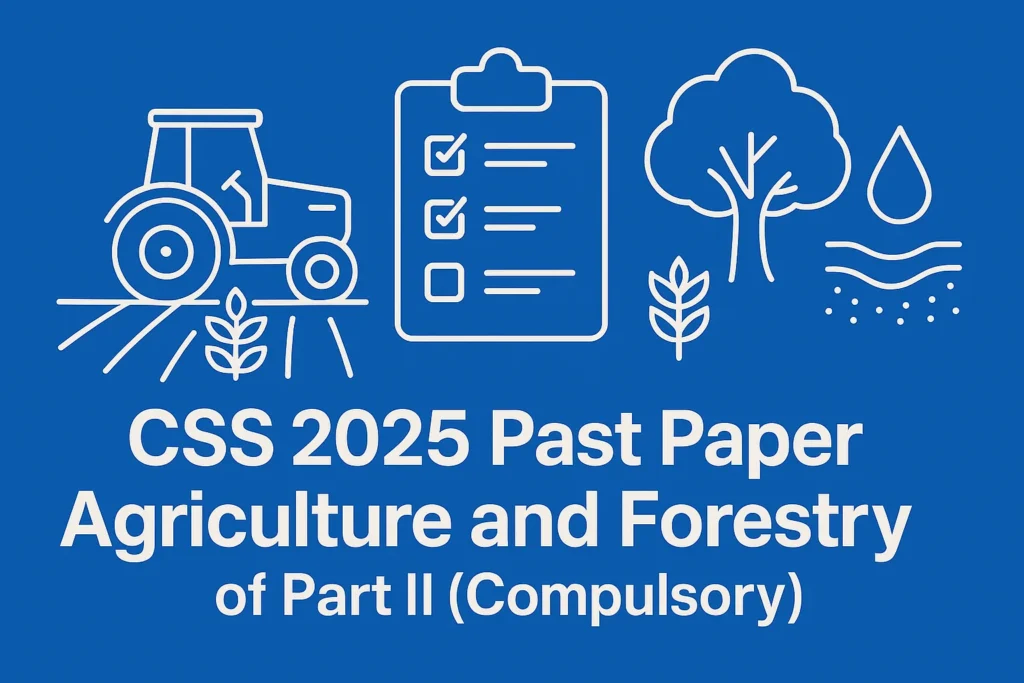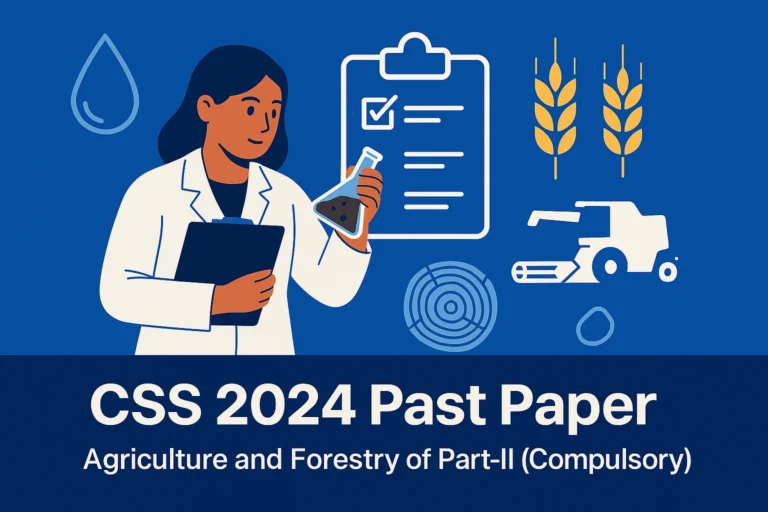CSS Past Paper 2025 Agriculture and Forestry Descriptive (Part 2)

CSS | Past Paper | Group 5 | 2025 | Part 2 | Descriptive
Below is the solution to PART-II (COMPULSORY) of the CSS Past Paper 2025 Agriculture and Forestry Descriptive (Part 2).
Question 2
Economy of any country lies in its natural resources besides its rapid industrial development. Elaborate the strategies for sustainable use of non-renewable resources along with capping the renewable resources.
Introduction
Natural resources are like the backbone of any country’s economy. They support industries, provide jobs, and help in development. But when we use them too much without thinking about the future, we damage the environment and risk losing these resources forever. So, we need smart strategies to use non-renewable and renewable resources sustainably.
Understanding Non-Renewable and Renewable Resources
- Non-renewable resources include oil, gas, coal, and minerals. These can’t be replaced once they are used.
- Renewable resources include water, forests, air, and sunlight. These can regenerate but still need to be used wisely.
Strategies for Sustainable Use of Non-Renewable Resources
(i) Resource Conservation
- We should reduce the unnecessary use of coal, oil, and gas.
- Promoting public transport can save a lot of fuel.
(ii) Alternative Energy Sources
- Use of solar, wind, and hydro power instead of fossil fuels.
- Encourage investment in renewable energy technologies.
(iii) Efficient Technology
- Machines and engines that consume less energy should be promoted.
- Industries should be made energy-efficient.
(iv) Recycling and Reuse
- Recycling metals like aluminum, copper, and iron can reduce the need for new mining.
- Using plastic alternatives can reduce oil-based production.
(v) Tax and Regulatory Policies
- Government should tax over-consumption and offer incentives for using eco-friendly resources.
- Laws must be strict for those who over-exploit non-renewables.
Capping and Managing Renewable Resources
Even though renewable resources can regenerate, they are also under threat due to overuse.
(i) Sustainable Forest Management
- Limit tree cutting and promote afforestation.
- Community-based forest projects should be introduced.
(ii) Water Conservation
- Use drip irrigation in agriculture to save water.
- Build rainwater harvesting systems in urban areas.
(iii) Fisheries and Livestock
- Seasonal bans should be imposed on fishing during breeding seasons.
- Avoid overgrazing to protect pastures.
(iv) Awareness and Education
- Educating people about responsible resource usage.
- Include environmental studies in schools and colleges.
Examples from Other Countries
- Norway: Uses hydro energy and has strict oil usage policies.
- Germany: Leading in solar and wind energy adoption.
- Pakistan should learn from these countries and apply such models locally.
Conclusion
To protect our economy and environment, we must treat natural resources like a trust from nature, not just something to exploit. By using modern technology, strong laws, and spreading awareness, we can make sure that our future generations also get to use these resources. Sustainable use is not a choice; it’s a need now.
Question 3
New Zealand’s grass fed cows produce some of the world’s best quality milk. Describe the factors which can influence the high quantity and high quality milk production of Pakistani dairy industry.
Introduction
Pakistan is the 4th largest milk-producing country in the world, but still, we face problems like low-quality milk, poor yield per animal, and unhygienic practices. Countries like New Zealand have achieved success by focusing on natural feeding, breed improvement, and modern dairy practices. Pakistan can also improve its dairy sector by focusing on the following factors:
Breed Improvement
- Local breeds like Sahiwal and Red Sindhi have good potential but their yield is still low.
- Crossbreeding with high-yielding exotic breeds (like Holstein Friesian, Jersey) can improve milk quantity.
- Artificial Insemination (AI) and Embryo Transfer techniques should be promoted.
Animal Nutrition
- In New Zealand, cows feed on fresh green grass, rich in nutrients. In Pakistan, animals mostly eat dry fodder and low-quality feed.
- Balanced diet with proper amount of protein, vitamins, and minerals can improve both milk quantity and quality.
- Use of Total Mixed Ration (TMR) can help farmers give balanced food daily.
Health Management
- Healthy animals give more and better milk. In Pakistan, diseases like mastitis, FMD, and parasites are common.
- Regular vaccination, deworming, and veterinary check-ups are important.
- Proper shelter and hygiene must be ensured to avoid infections.
Milking Practices
- In rural areas, milking is done by hand without cleanliness, which affects milk quality.
- Use of clean stainless-steel buckets, filtered milk, and chilling systems should be introduced.
- Mechanized milking can also reduce contamination and improve hygiene.
Genetics and Selection
- Farmers should select animals based on milk yield records, udder shape, and overall body health.
- Poor genetics result in low-yielding animals which cost more but give less output.
Training and Extension Services
- Most dairy farmers in Pakistan are untrained and follow traditional methods.
- Government and NGOs should run training workshops on feeding, breeding, milking, and disease control.
- Use of mobile apps and SMS services can also help farmers learn easily.
Cold Chain and Storage
- Milk spoils fast in hot areas. New Zealand uses chilling tanks on farms to keep milk fresh.
- Establishing mini milk collection centers with chillers in rural areas can reduce spoilage.
Government Support and Policy
- Subsidies for dairy equipment, loans for farm improvement, and setting milk quality standards are needed.
- Regular testing of milk at shops can ensure quality and consumer trust.
Role of Private Sector
- Companies like Nestlé and Engro are working with farmers. Such public-private partnerships should be expanded.
- Dairy cooperatives should be formed to support small farmers.
Climate and Environmental Conditions
- Climate also affects milk yield. Pakistan’s extreme heat reduces animal performance.
- Shaded areas, fans, and proper ventilation in sheds can improve comfort and productivity.
Conclusion
Pakistan has all the potential to produce milk like New Zealand — we have land, animals, and hardworking farmers. But without modern methods, clean practices, and proper planning, we can’t compete globally. If we improve breeds, feed, health, and farm management, our dairy sector can not only produce more milk, but also better-quality milk that meets international standards.
Question 4
Our agricultural system is crippled by land structure and depleting soil nutrients. Suggest concrete measures to help restore the soil formation and maintain the nutrient level of our soils.
Introduction
Agriculture in Pakistan is heavily dependent on soil health. But due to over-farming, chemical misuse, waterlogging, and poor land management, our soils are losing fertility. If this continues, future crop production will be badly affected. To solve this issue, we need to take practical steps to improve soil structure and nutrient content.
Problems with Land Structure and Soil Nutrients
(i) Fragmented Land Holdings
- Farms are divided into small, scattered plots. It becomes hard to use modern machines and efficient methods.
(ii) Soil Erosion
- Wind and water erosion is common, especially in hilly and arid areas.
(iii) Overuse of Chemicals
- Farmers use too much chemical fertilizers and pesticides. This harms soil microbes and reduces fertility.
(iv) Salinity and Waterlogging
- Improper irrigation has made many soils salty or flooded, especially in Sindh and South Punjab.
Concrete Measures to Restore Soil Formation
(i) Land Consolidation
- Government should promote programs where small farmers combine land for better management and use of machines.
(ii) Terracing and Contour Farming
- On slopes, building terraces and planting across the slope can stop erosion.
(iii) Organic Matter Addition
- Add farmyard manure (FYM), compost, and crop residues to increase humus and improve soil structure.
(iv) Agroforestry
- Growing trees with crops prevents erosion and adds organic matter.
Maintaining and Improving Nutrient Levels
(i) Balanced Fertilizer Use
- Instead of using only urea, farmers should apply NPK fertilizers as per soil test results.
(ii) Bio-fertilizers and Green Manure
- Use of Rhizobium for legumes, Azotobacter for cereals, and green manure like Sesbania helps improve nitrogen naturally.
(iii) Crop Rotation
- Rotating cereals with legumes (like wheat → mash) helps fix nitrogen and improves soil health.
(iv) Micronutrient Management
- Deficiency of Zinc, Boron, Iron is common. Use of micronutrient fertilizers is important.
Water Management for Healthy Soil
- Drip irrigation and laser leveling reduce water waste and prevent waterlogging.
- Good drainage systems should be built in areas with high groundwater to avoid salinity.
Farmer Education and Soil Testing
- Many farmers apply fertilizers without knowing soil needs. Regular soil testing should be promoted.
- Government and NGOs must train farmers on proper fertilizer use, compost making, and erosion control.
Government Role and Policy
- Subsidies for organic inputs, bio-fertilizers, and soil conditioners can help small farmers.
- Soil Health Cards like in India can guide farmers crop-wise.
Success Stories and Examples
- In Punjab, use of compost and green manures in some model villages improved wheat yield by 25%.
- Countries like Brazil and China have adopted integrated soil fertility management, which Pakistan can also follow.
Conclusion
Soil is our most valuable asset in agriculture. But due to neglect and misuse, it is becoming weak and tired. To feed the growing population and ensure food security, we must act now. By adopting modern, eco-friendly, and scientific methods, we can bring life back to our soils and make farming sustainable for future generations.
Question 5
Write short notes on the following:
a. Use of Speed breeding technology
b. Issues of hybrid wheat development
c. Reasons for breakdown of disease resistance
d. Scope of farm mechanization in Pakistan
a. Use of Speed Breeding Technology
Introduction
Speed breeding is a modern technique used to grow plants faster and get more generations in a year. Normally, crops like wheat or barley take months to grow, but with speed breeding, scientists can grow up to 6 generations per year instead of 1 or 2.
This is done by:
- Giving longer light hours (about 22 hours/day) using LED lights in controlled environments.
- Controlling temperature and humidity to speed up flowering and seed setting.
Benefits
- Helps in fast development of new varieties.
- Saves time in breeding programs.
- Useful in climate change scenarios where fast-growing varieties are needed.
Countries like Australia and UK are using it actively, and Pakistan can also adopt this for faster crop improvement.
b. Issues of Hybrid Wheat Development
Introduction
Hybrid wheat has the potential to give higher yields, but there are many challenges in developing and using it.
Key Issues
- Complex genetics: Wheat is a self-pollinated crop, so making hybrid seeds is hard compared to crops like maize.
- High seed cost: Hybrid wheat seeds are expensive and many farmers can’t afford them.
- Low hybrid vigor: The yield advantage in hybrids is not always big enough to attract farmers.
- Seed multiplication: Producing enough hybrid seed is a challenge in countries like Pakistan.
Still, with proper research and investment, these issues can be managed for better future use.
c. Reasons for Breakdown of Disease Resistance
Introduction
Crops are often bred to resist diseases, but over time this resistance can break down. This means the crop becomes vulnerable again.
Reasons Includes
- Pathogen mutation: Disease-causing organisms (like fungi or bacteria) change over time and overcome plant defenses.
- Monoculture: Growing the same variety over large areas makes it easy for diseases to spread.
- Overuse of chemicals: Excess pesticide use can lead to resistant strains of pests or pathogens.
- Climate change: New weather patterns can increase the survival and spread of diseases.
To avoid this, crop rotation, use of diverse varieties, and regular breeding programs are necessary.
d. Scope of Farm Mechanization in Pakistan
Introduction
Farm mechanization means using machines in farming instead of manual labor. In Pakistan, only about 45-50% farms are partially mechanized, and the rest still use traditional methods.
Scope Includes
- Increasing efficiency: Tractors, harvesters, seeders save time and labor.
- Reducing losses: Mechanized harvesting reduces post-harvest losses.
- Better land use: Precision tools help in proper fertilizer and seed use.
- Youth attraction: Use of tech and machines can attract young people to farming.
Challenges
- Small land size, high cost of machines, and lack of training.
Government should offer subsidies, promote cooperative farming, and open machine rental centers to support mechanization.
Conclusion
These four topics show how modern techniques and challenges are shaping our agriculture. Pakistan has the potential to improve its crop production and food security by solving these problems with the right policies and innovations.
Question 6
Trees are called the lungs of the earth and are important component of biodiversity but deforestation is taking place at an accelerated rate. Propose a concrete plan by which requisite goods and services are provided to the community without damaging the biodiversity.
Introduction
Trees play a huge role in maintaining life on Earth. They give us oxygen, food, wood, and climate control, and also support biodiversity by being home to birds, insects, and other animals. But sadly, due to rapid deforestation, our environment and biodiversity are under threat. A balance must be created between economic needs and environmental protection.
Causes of Rapid Deforestation
- Timber harvesting for furniture and construction
- Expansion of agriculture
- Fuelwood collection in rural areas
- Illegal logging
- Urbanization and housing schemes
All these activities provide goods and services, but they are harming biodiversity badly.
Concrete Plan for Sustainable Goods and Services
(i) Community-Based Forest Management (CBFM)
- Involve local people in forest protection.
- Give them share in forest produce (e.g. honey, fruits, medicinal plants) without cutting trees.
- Success example: Social forestry in India and Nepal.
(ii) Agroforestry Systems
- Encourage farmers to grow trees with crops (like moringa, acacia, or fruit trees).
- This gives them income and wood, while keeping biodiversity safe.
(iii) Non-Timber Forest Products (NTFPs)
- Promote collection and sale of forest goods like mushrooms, herbs, gums, resins, etc.
- These do not require cutting trees and can become a big source of income.
(iv) Eco-Tourism
- Develop forest parks and eco-tourism zones.
- Local people can work as guides, run food stalls, and earn from tourism.
- Protects biodiversity while supporting economy.
(v) Plantation of Fast-Growing Trees
- For timber and fuelwood, plant trees like eucalyptus or poplar on separate lands (not natural forests).
- Helps reduce pressure on native forests.
(vi) Forest Zoning
- Divide forest areas into core (protected) and buffer (limited use) zones.
- Strict protection in core areas; sustainable use in buffer areas.
(vii) Alternative Energy Sources
- Provide solar cookers, biogas plants to reduce fuelwood cutting.
- In rural Pakistan, 60% people use wood for cooking.
(viii) Strict Laws and Monitoring
- Enforce forest laws to stop illegal logging.
- Use satellite monitoring and drones for forest protection.
Public Awareness and Education
- Teach people about the value of trees and biodiversity.
- Campaigns in schools, mosques, and through media.
- “One student, one tree” programs can be started.
Role of Government and NGOs
- Govt should give incentives for forest conservation.
- NGOs can support in awareness, plantation drives, and community training.
- Example: WWF Pakistan has worked in mangrove restoration successfully.
Examples from Other Countries
- Costa Rica: Pays money to farmers who protect forests (Payment for Ecosystem Services).
- China: Converted degraded lands into forests under the “Green Wall” project.
Pakistan can learn from these models.
Conclusion
If we keep cutting trees without thinking, we will face climate disasters, floods, and food shortage. But if we apply smart and inclusive strategies, we can meet community needs and save biodiversity together. The key is to shift from exploitation to sustainable use of our natural wealth.
Question 7
Forests have a special importance in the human life and as well as for economic development of any country. Critically discuss the reasons for low forest cover in Pakistan and suggest concrete measures to increase the forest area.
Introduction
Forests are one of the most valuable resources for any country. They provide oxygen, wood, food, shelter for wildlife, and protect the soil and water cycle. Economically, forests support timber industries, jobs, and even tourism. But Pakistan has only about 4.8% forest cover, which is far below the global standard of 25%.
Importance of Forests
- Environmental: Control floods, prevent erosion, absorb carbon dioxide, and support biodiversity.
- Economic: Provide wood, medicinal plants, fuelwood, fruits, and support rural economies.
- Social: Offer recreation, employment, and maintain cultural linkages with nature.
Reasons for Low Forest Cover in Pakistan
(i) Rapid Population Growth
- Rising population needs more land for housing and farming, leading to cutting of trees.
(ii) Deforestation for Fuelwood
- In rural areas, around 60-70% of people use wood for cooking and heating.
(iii) Urbanization and Infrastructure
- Road projects, housing schemes, and industries clear forests without replantation.
(iv) Illegal Logging
- Timber mafia and weak enforcement cause huge forest loss, especially in KPK and Azad Kashmir.
(v) Overgrazing
- Livestock damage young saplings and destroy regeneration of forests.
(vi) Lack of Awareness
- People do not understand the importance of forests in everyday life or in fighting climate change.
(vii) Policy Gaps
- No strong implementation of forest protection laws, and poor coordination between departments.
(viii) Climate Change
- Changing rainfall patterns, floods, and droughts affect natural forest growth.
Concrete Measures to Increase Forest Area
(i) Mass Plantation Campaigns
- Projects like “Ten Billion Tree Tsunami” must continue with transparency and local participation.
- Trees should be planted on roadsides, schools, barren lands, and in cities.
(ii) Community Forest Management
- Engage locals in protecting forests and sharing forest benefits.
- Give jobs to forest guards from local population.
(iii) Agroforestry
- Encourage farmers to plant trees along with crops. This adds income and increases tree cover.
(iv) Strict Laws and Penalties
- Enforce heavy fines and jail for illegal tree cutting.
- Use drones and satellite images to monitor forest loss.
(v) Green Urban Planning
- Cities must include green belts, parks, and vertical gardens in planning laws.
(vi) Promotion of Alternate Fuel Sources
- Solar cookers and biogas plants can reduce dependency on wood fuel.
(vii) Public Awareness
- School-level tree plantation drives, social media campaigns, and forest education in textbooks.
(viii) Private Sector Involvement
- Timber industries and corporate businesses should be asked to plant trees as part of Corporate Social Responsibility (CSR).
International Models for Inspiration
- Turkey: Celebrated National Tree Plantation Day and planted millions of trees in a single day.
- China: Converted deserts into forests under its Great Green Wall project.
- India: Madhya Pradesh planted over 6 crore trees in one day as a world record.
Pakistan can learn and apply similar models according to its conditions.
Conclusion
Pakistan’s forest cover is dangerously low, and without urgent action, it will cause more disasters like floods, soil erosion, and climate shocks. Forests are not just about trees—they are about life, economy, and future survival. With the right policies, public involvement, and strong enforcement, we can increase our forest area and build a greener Pakistan.
Question 8
Write short notes on the following:
a. Miyawaki method of forest plantation
b. Prevention of forest fire
c. Threats to mangrove forests
d. Role of mulberry in pollen allergy
a. Miyawaki Method of Forest Plantation
Introduction
The Miyawaki method is a Japanese technique for growing forests in a short time and small space. It was developed by Dr. Akira Miyawaki, a botanist. This method is good for urban areas where land is limited.
Key Features
- Use of native (indigenous) plant species only.
- Plants are densely planted (3 to 5 plants per square meter).
- Soil is improved with organic compost, mulch, and natural fertilizers.
- Forest grows 10 times faster and is 30 times denser than traditional plantation.
Benefits
- Quick restoration of green areas
- Low maintenance after 2-3 years
- Supports biodiversity in cities
In Pakistan, this method is being used in Lahore, Karachi, and Islamabad by local governments and NGOs.
b. Prevention of Forest Fire
Introduction
Forest fires are dangerous and destroy trees, wildlife, and soil quality. In recent years, Pakistan saw fires in Margalla Hills, Swat, and Balochistan. These are caused by dry weather, human activity, and lightning.
Prevention Strategies
- Fire breaks – Clear strips of land to stop fire from spreading.
- Watch towers – For early detection of smoke or fire.
- Community patrols – Local volunteers can monitor forests during summer.
- Awareness campaigns – Educate people not to throw cigarette butts or burn garbage in forests.
- Use of drones – For quick spotting of fire in remote areas.
Pakistan must build better response teams and invest in firefighting equipment to prevent forest damage.
c. Threats to Mangrove Forests
Introduction
Mangroves grow in coastal areas and are very important for fish breeding, water purification, and protecting coastlines. Pakistan’s mangroves are mainly found in Sindh (Indus Delta) and parts of Balochistan.
Major Threats
- Urban expansion and pollution
- Cutting mangroves for fuelwood
- Industrial waste and oil spills
- Seawater intrusion due to low river flow
- Climate change and rising sea levels
To save them, Pakistan needs to:
- Enforce coastal protection laws
- Replant mangroves regularly
- Engage local communities in mangrove conservation
WWF and Sindh Forest Department have done good work in mangrove planting in recent years.
d. Role of Mulberry in Pollen Allergy
Introduction
Mulberry trees (known as “Shahtoot”) are a major cause of pollen allergy, especially in Islamabad and Rawalpindi during spring.
Why It Causes Allergy?
- Male mulberry trees produce large amounts of dry pollen, which easily spreads in air.
- The pollen is very light and enters human nose and lungs, causing sneezing, asthma, and eye irritation.
Possible Solutions
- Replace male mulberry trees with female trees (which don’t produce pollen).
- Shift to non-allergic tree species like Neem, Amaltas, and Gulmohar.
- Municipal authorities should regulate tree plantation in urban areas.
Public should also be educated on avoiding exposure and using masks during pollen season.
Conclusion
These four topics show how important forest and environmental management is for our health, economy, and future. With smart methods like Miyawaki, awareness on fire safety, protecting mangroves, and replacing allergy-causing trees like mulberry, Pakistan can make its cities greener and safer.
📘 Benefits of Practicing This Descriptive Paper
- ✅ These CSS Past Paper 2025 Agriculture and Forestry Descriptive questions are compiled from authentic FPSC CSS past papers, following the real written exam format.
- 💬 Attempting this CSS Past Paper 2025 Agriculture and Forestry Descriptive helps students master structured writing and analytical skills for CSS exams.
- 🧾 Every question in this CSS Past Paper 2025 Agriculture and Forestry Descriptive strictly follows the official CSS exam syllabus approved by FPSC.
- 📊 Students preparing for CSS 2025 can rely on this CSS Past Paper 2025 Agriculture and Forestry Descriptive to practice time management and topic selection.
- 🔍 The solved CSS Past Paper 2025 Agriculture and Forestry Descriptive contains concise explanations to improve conceptual understanding and writing clarity.
- 🎯 Regular revision of this CSS Past Paper 2025 Agriculture and Forestry Descriptive builds confidence and strengthens your preparation for the CSS written paper.
- 🏆 This CSS Past Paper 2025 Agriculture and Forestry Descriptive is essential for mastering exam techniques and achieving success in the FPSC CSS 2025 examination.
🏁 Final Note
Keep revising these CSS Past Paper 2025 Agriculture and Forestry Descriptive to strengthen your grip on important concepts and improve accuracy in upcoming CSS exams. Regular practice with these CSS Past Paper 2025 Agriculture and Forestry Descriptive will help you score higher and build full command over the CSS exam syllabus.
👉 Also read CSS Past Paper 2025 Agriculture and Forestry (Part-I MCQs)
🔗 Check FPSC past papers directly from the official FPSC website.






